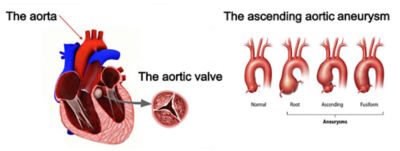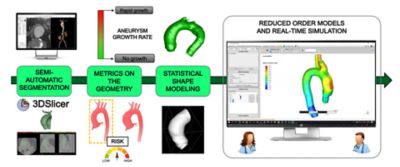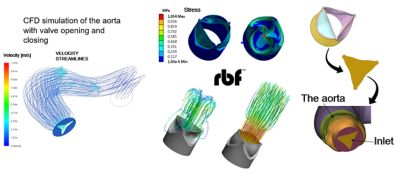ANSYS BLOG
February 13, 2023
Diagnosing Aneurysms in a Heartbeat with Ansys
Heart conditions remain a leading cause of death in the world according to the World Health Organization (WHO). Among them, ascending aorta aneurysms (AsAAs) are very common, life-threatening cardiovascular diseases characterized by an abnormal bulging or a weak spot in the aorta, the main artery in the human body. Most of us are familiar with aneurysms, as they have a scary reputation for causing a blood vessel to burst suddenly — and, too often, fatally.
However, an AsAA diagnosis isn’t always a death sentence. In some cases, effective treatment requires a few lifestyle changes or — in more severe cases — surgery. The good news is that among those who have AsAA surgery, 79% will survive for at least 10 years after treatment.
In the case of a rupture, however, the first 48 hours are critical. Without emergency surgery during those first 48 hours, only half can expect to survive.1 In any event, a detailed clinical assessment and definitive diagnosis based on family history, medical expertise, and relevant testing involving different imaging technologies can factor heavily in a patient’s survival.

The anatomy and the clinical problem. The criterion to perform ascending aortic aneurysm surgery is currently based only on the evaluation of the ascending aorta diameter.
In the future, within the confines of one day within a simulation environment, it may be possible for a medical team to more quickly and accurately identify what to do in the case of an aneurysm, then take immediate action to successfully treat it. To be clear, this activity would not happen in a vacuum. It would also be guided by the expertise of the attending physician, the assessment of the greater medical team, and various imaging and test results.
A Twinning Strategy for the Future of Aneurysm Prevention and Treatment
Thanks to MeDiTATe — the medical digital twin for aneurysm prevention and treatment — simulation may become an important factor in the diagnosis and treatment of aneurysms. MeDiTATe research is supported by a longstanding partnership between Ansys and software company RBF Morph.
There are currently three MeDiTATe research projects focused on using digital twins that are interconnected with some participant overlap. RBF Morph is enabling the use of mesh morphing with Ansys computer-aided engineering (CAE) solutions and Ansys Twin Builder in all three projects to develop a better understanding of AsAAs and other medical conditions.
“Coming into MeDiTATe we already have activities around this topic,” says Dr. Marco Evangelos Biancolini, RBF Morph CTO and Founder, and Associate Professor of Machine Design at the University of Rome Tor Vergata. “We consider aneurysm research to be really important and really difficult, involving academia and the medical industry working together for a common objective. We have a $4 million budget for this project with many partners including Ansys, plus 14 researchers that are 100% committed to this effort, which amounts to a medical digital twin task force of almost 100 people.”
MeDiTATe’s large consortium of researchers are working together with Ansys using medical imaging segmentation software. Researchers compare the images of a patient with the reduced-order model (ROM) generated in Twin Builder to see, in real time, the evolution of the pathology. Using this medical digital twin model, they can then augment the images with simulation results, enabling them to extract indexes/biomarkers and further understand what’s going on medically.

Digital twin and real time simulation.
Ultimately, the creation of a medical digital twin in Twin Builder could enable a high-fidelity simulation of the patient for a patient-specific geometry. The goal is to provide additional information to the surgeon and reduce the mortality rate of an aneurysm event. Using a medical digital twin introduces greater certainty in the medical decision-making process, supported by additional evidence and knowledge.
“Obviously, if I’m a patient and I have this condition, and you provide one more perspective or additional information to help me make this decision, that’s always better,” says Biancolini. “Introducing simulation gives you more authoritative, well-defined information based on additional technology. In the future, it’s also possible that a digital twin may become an important component or part of a medical device, such as a digital twin onboard of an ultrasound.”
Ansys Software Enables New Pathways to Recovery
In the face of many unknowns, the extensive use of simulation comes with several benefits for the MeDiTATe team in the deployment of Ansys-based medical digital twins. It’s reflected first in the collective experience using high fidelity simulation software including Ansys Fluent, Ansys Mechanical, and Ansys LS-Dyna. All three are integral in the study of fluids, structures, and electrophysiology fluid-structural interactions that are a big part of the team’s work. MeDiTATe researchers are also deploying solutions with Twin Builder that make ROM generation effective and user friendly in the process.
Working with very well-established tools in support of new technologies for digital twin development enables researchers to approach their work with more clarity knowing where they are headed, and the challenges they can expect along the way.
“To deploy effective medical digital twins you need the state-of-the-art data coming out of our research, yet this is not enough,” says Biancolini. “You also need two different things — one is reduced-order model data compression, which can be obtained by high-performance computing, and a model to run it on. Twin Builder enables us to extract a large amount of data then use it to create a model that, instead of running many hours of calculations, can run in real time. The ability of advanced visualization makes translation possible so this data can be used in the medical world.”
Mesh Morphing and Twin Building into Three Dimensions

Study of the aortic valve using RBF mesh morphing.
RBF Morph mesh morphing technology is a key enabler of parametric shapes and forms — shapes that have a curving nature. The software is not only useful in defining shape parameters — for instance, the positioning of a prosthetic part — but is also needed for statistical shape modeling (i.e. to extract common shape features of a patient cohort). It’s extremely helpful during projects when researchers are tasked with creating generic patients. If a statistical model is built with a large cohort, the software enables the digital twin coming out of Twin Builder to easily adapt to and represent a new patient without the need for further CAE computations.
Currently this method is being applied to an aortic arch so that a full-flow simulation of a new patient is readily available in the 3D Slicer software used for medical image segmentation. This leads to successful 3D image data extraction of regions of interest (ROIs) from cross-sectional imaging modalities such as magnetic resonance imaging (MRI) or computed tomography (CT) scans. Using a similar process, the DITAID (digital twin for airflow and drug delivery in human airways) team is also creating parametric airways to enable a more patient-based approach to decide which drug deliveries are needed to treat various pulmonary conditions.
The potential for medical digital twins is enormous, from optimizing eye surgery to producing personalized, cell-based respiratory therapies, to improving aortic surgery outcomes. Visit our website to learn more about Ansys Twin Builder, and take advantage of a free trial too.